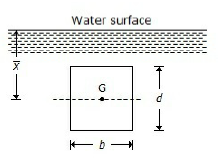According to the principle of buoyancy a body totally or partially immersed in a fluid will be lifted up by a force equal to
The weight of the body
More than the weight of the body
Less than the weight of the body
Weight of the fluid displaced by the body
Correct Answer :
D. Weight of the fluid displaced by the body
Related Questions
The capillary rise at 20°C in a clean glass tube of 1 mm bore containing water is approximately
5 mm
10 mm
20 mm
30 mm
The pressure measured with the help of a Piezometer tube is in
N/mm2
N/m2
Head of liquid
All of these
An object having 10 kg mass weighs 9.81 kg on a spring balance. The value of 'g' at this place is
10 m/sec²
9.81 m/sec²
9.75 m/sec²
9 m/sec
The ratio of the inertia force to the __________ is called Euler's number.
Pressure force
Elastic force
Surface tension force
Viscous force
All the terms of energy in Bernoulli's equation have dimension of
Energy
Work
Mass
Length
Fluid is a substance which offers no resistance to change of
Pressure
Flow
Shape
Volume
The buoyancy depends on
Mass of liquid displaced
Viscosity of the liquid
Pressure of the liquid displaced
Depth of immersion
Ratio of inertia force to surface Jension is known as
Mach number
Froude number
Reynoldss number
Weber's number
A piece of metal of specific gravity 7 floats in mercury of specific gravity 13.6. What fraction of its volume is under mercury?
0.5
0.4
0.515
0.5
A vertically immersed surface is shown in the below figure. The distance of its centre of pressure from the water surface is 
(bd²/12) + x
(d²/12 x) + x
b²/12 + x
d²/12 + x
The value of coefficient of discharge is __________ the value of coefficient of velocity.
Less than
Same as
More than
None of these
A fluid which obeys the Newton's law of viscosity is termed as
Real fluid
Ideal fluid
Newtonian fluid
Non-Newtonian fluid
Liquids
Cannot be compressed
Occupy definite volume
Are not affected by change in pressure and temperature
None of the above
The shear stress between the two liquid layers is __________ proportional to the distance between two layers.
Directly
Inversely
Both A and B
None of these
A one dimensional flow is one which
Is uniform flow
Is steady uniform flow
Takes place in straight lines
Involves zero transverse component of flow
The force of buoyancy is always __________ the weight of the liquid displaced by the body.
Equal to
Less than
More than
None of these
The point in the immersed body through which the resultant pressure of the liquid may be taken to act is known as
Meta center
Center of pressure
Center of buoyancy
Center of gravity
According to Bernoulli's equation
Z + p/w + v²/2g = constant
Z + p/w - v²/2g = constant
Z - p/w + v²/2g = constant
Z - p/w - v²/2g = constant
The unit of kinematic viscosity in S. I. units is
N-m/s
N-s/m2
m2/s
N-m
With an increase in size of tube, the rise or depression of liquid in the tube due to surface tension will
Decrease
Increase
Remain unchanged
Depend upon the characteristics of liquid
The discharge through a convergent mouthpiece is __________ the discharge through an internal mouthpiece of the same diameter and head of water.
Equal to
One-half
Three fourth
Double
The liquid used in manometers should have
Low density
High density
Low surface tension
High surface tension
Flow occurring in a pipeline when a valve is being opened is
Steady
Unsteady
Laminar
Vortex
The ratio of the inertia force to the viscous force is called
Reynold's number
Froude's number
Weber's number
Euler's number
Uniform flow occurs when
The direction and magnitude of the velocity at all points are identical
The velocity of successive fluid particles, at any point, is the same at successive periods of time
The magnitude and direction of the velocity do not change from point to point in the fluid
The fluid particles move in plane or parallel planes and the streamline patterns are identical in each pleasure
Coefficient of resistance is the ratio of
Actual velocity of jet at vena-contracta to the theoretical velocity
Area of jet at vena-contracta to the area of orifice
Loss of head in the orifice to the head of water available at the exit of the orifice
Actual discharge through an orifice to the theoretical discharge
According to Newton's law of viscosity, the shear stress on a layer of a fluid is __________ to the rate of shear strain.
Equal to
Directly proportional
Inversely proportional
None of these
Metacentric height is given as the distance between
The center of gravity of the body and the metacentre
The center of gravity of the body and the center of buoyancy
The center of gravity of the body and the center of pressure
Center of buoyancy and metacentre
The discharge through a large rectangular orifice is given by (where H1 = Height of the liquid above the top of the orifice, H2 = Height of the liquid above the bottom of the orifice, b = Breadth of the orifice, and Cd = Coefficient of discharge)
Q = (2/3) Cd × b × √(2g) × (H2 - H1)
Q = (2/3) Cd × b × √(2g) × (H2 1/2 - H1 1/2)
Q = (2/3) Cd × b × √(2g) × (H2 3/2 - H1 3/2)
Q = (2/3) Cd × b × √(2g) × (H2 2 - H1 2)
The mass of 2.5 m3 of a certain liquid is 2 tonnes. Its mass density is
200 kg/m3
400 kg/m3
600 kg/m3
800 kg/m3
